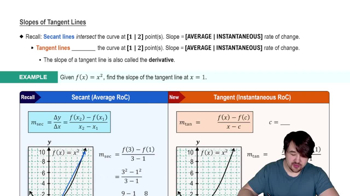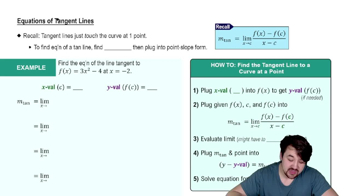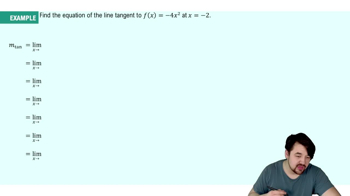Table of contents
- 0. Functions7h 52m
- Introduction to Functions16m
- Piecewise Functions10m
- Properties of Functions9m
- Common Functions1h 8m
- Transformations5m
- Combining Functions27m
- Exponent rules32m
- Exponential Functions28m
- Logarithmic Functions24m
- Properties of Logarithms34m
- Exponential & Logarithmic Equations35m
- Introduction to Trigonometric Functions38m
- Graphs of Trigonometric Functions44m
- Trigonometric Identities47m
- Inverse Trigonometric Functions48m
- 1. Limits and Continuity2h 2m
- 2. Intro to Derivatives1h 33m
- 3. Techniques of Differentiation3h 18m
- 4. Applications of Derivatives2h 38m
- 5. Graphical Applications of Derivatives6h 2m
- 6. Derivatives of Inverse, Exponential, & Logarithmic Functions2h 37m
- 7. Antiderivatives & Indefinite Integrals1h 26m
- 8. Definite Integrals4h 44m
- 9. Graphical Applications of Integrals2h 27m
- 10. Physics Applications of Integrals 2h 22m
2. Intro to Derivatives
Tangent Lines and Derivatives
Problem 44a
Textbook Question
Use the definition of the derivative to determine d/dx (√ax+b), where a and b are constants.
 Verified step by step guidance
Verified step by step guidance1
Step 1: Recall the definition of the derivative, which is given by the limit: \( f'(x) = \lim_{h \to 0} \frac{f(x+h) - f(x)}{h} \).
Step 2: Identify the function \( f(x) = \sqrt{ax + b} \) and substitute it into the definition of the derivative.
Step 3: Compute \( f(x+h) = \sqrt{a(x+h) + b} = \sqrt{ax + ah + b} \).
Step 4: Substitute \( f(x) \) and \( f(x+h) \) into the derivative definition: \( f'(x) = \lim_{h \to 0} \frac{\sqrt{ax + ah + b} - \sqrt{ax + b}}{h} \).
Step 5: To simplify the expression, multiply the numerator and the denominator by the conjugate of the numerator: \( \frac{\sqrt{ax + ah + b} - \sqrt{ax + b}}{h} \times \frac{\sqrt{ax + ah + b} + \sqrt{ax + b}}{\sqrt{ax + ah + b} + \sqrt{ax + b}} \).
 Verified video answer for a similar problem:
Verified video answer for a similar problem:This video solution was recommended by our tutors as helpful for the problem above
Video duration:
5mPlay a video:
Was this helpful?
Key Concepts
Here are the essential concepts you must grasp in order to answer the question correctly.
Definition of the Derivative
The derivative of a function at a point measures the rate at which the function's value changes as its input changes. Formally, it is defined as the limit of the average rate of change of the function as the interval approaches zero. This concept is foundational in calculus, as it provides a way to understand how functions behave locally.
Recommended video:

Definition of the Definite Integral
Limit Process
The limit process is a fundamental concept in calculus that allows us to evaluate the behavior of functions as they approach a certain point. In the context of derivatives, it involves taking the limit of the difference quotient, which is the ratio of the change in the function's value to the change in the input, as the change in input approaches zero. This process is crucial for defining derivatives accurately.
Recommended video:

One-Sided Limits
Chain Rule
The chain rule is a formula for computing the derivative of the composition of two or more functions. It states that if you have a function that is the composition of two functions, the derivative can be found by multiplying the derivative of the outer function by the derivative of the inner function. This rule is particularly useful when differentiating functions like √(ax + b), where the inner function is ax + b and the outer function is the square root.
Recommended video:

Intro to the Chain Rule

 5:13m
5:13mWatch next
Master Slopes of Tangent Lines with a bite sized video explanation from Nick
Start learningRelated Videos
Related Practice




